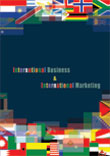International Business and International Marketing
 |
Details
Textbook:
Pages : 328;
Paperback;
210 X 275 mm approx.
Suggested Case Studies
Workbook:
Pages :
280; Paperback;
210 X 275 mm approx, Sample Applied Theory Questions
Sample Multiple Choice Questions (Online Quiz)
Pricing
Textbook Price: Rs. 750;
Workbook Price: Rs. 700;
Available only in INDIA
Buy Now
Please allow 5 to 10 days for delivery.
Detail Table of Contents
Competitive Strategy in International Business : Chapter 5
SUMMARY:
Any effort to formulate a competitive strategy has to be preceded by a clear understanding of competition. Competition in an industry is determined by customers, suppliers, potential entrants, existing competitors and substitute products. Once a firm understands the forces driving competition in the marketplace, it can understand its strengths and weaknesses in the context of the industry.
|
|
Firms operating in international markets operate in a highly competitive marketplace. To succeed, they need a strategy that sets them apart from competitors. These strategies including transfer of core competencies. Multinational strategy concentrates on customization of products, which increases the cost of production. The system for transferring core competencies from headquarters to subsidiaries, and the system for sharing skills, technology and know- how among subsidiaries are not yet well developed or utilized.
This frequently creates problems for MNCs. Companies that increased overseas expansion after World War II adopted this strategy. The top management of the parent company takes full control of the subsidiary with the help of sophisticated management information systems and corporate staff, who are often specialists in the area. The top management maintains a continuous flow of information to guide subsidiaries. Global strategy was adopted by companies that expanded worldwide after World War II. The diminishing trade and tariff barriers and converging global markets encouraged these companies to implement this strategy.



